
It’s been a week of celebration at Tesco HQ as the CMA gave the provisional all-clear for its £3.7bn takeover of Booker.
But the mood has ranged from despondent to suicidal among the wider wholesale community, with Landmark MD John Mills willing to “lay down in front of the tanks” if the deal goes ahead, while experts and analysts have expressed shock that the CMA probe does not appear to have lead to any remedies, with Shore Capital analyst Clive Black dubbing the CMA the “Comedy Markets Authority” and accusing it of living in “a different universe”. So what’s happened?
Why has the CMA given the merger an all-clear after identifying areas of concern? When the CMA opened its phase two investigation into the merger in July, it identified 350 local hotspots where there was overlap between Tesco stores and Booker-supplied stores.
At the time, the CMA feared shoppers in these areas could face a reduction in competition. But this week’s report makes no mention of these 350 hotspots..
Observers have been left “shocked” by the CMA’s decision. One experienced merger watcher told the Grocer: “You would not normally expect to see the language change like that between different stages of a CMA investigation and the 350 hotspots have just disappeared.” It’s all the more surprising since there appeared to be a precedent, given its public concerns over stores within a one-mile radius or a five-minute drive of each other when McColl’s acquired 298 Co-ops earlier this year.”The fear, from Tesco’s point of view, that it would face a long and complicated sell off of stores, was based not just on this CMA investigation but the evidence from previous probes. In January, the authority said it could be a threat to competition on the grounds that a store fascia count in one area could decrease from four to three, three to two, or two to one fascia as a result,” the expert merger source added.
In February, exclusive research for The Grocer by Maximise found 246 of the Tesco/Booker stores were both within a one-mile radius and a five-minute drive.
Maximise’s research found the South East alone had a potential 55 overlapping Tesco-Booker stores, with a further 42 in Wales and 24 in East Anglia.
“With 246 sites failing both tests I believe these are by far the most vulnerable in terms of having to be sold off and the CMA will be trying to establish the merits of what can be kept or sold to competitors,” Maximise founder David Haywood told The Grocer.
Although seasoned experts say it is unusual for the competition authority to drop all mention of hotspots in this way, a CMA source vehemently denied it had altered the focus on the probe. That it had looked at a total of 12,000 shops showed it had been “if anything even more thorough”.
So why does the CMA think Tesco/ Booker won’t harm competition in convenience? Perhaps the biggest shock for some observers was the CMA’s verdict that a merged Tesco-Booker would simply not be big enough to destroy competition in the convenience sector. Considering Tesco operates more than 3,000 stores across the UK, while Booker supplies more than 5,000 stores under the Premier, Londis, Budgens and Family Shopper brands, it’s a decision many will find hard to stomach.
Ever since the merger plans were announced Tesco CEO Dave Lewis and Booker boss Charles Wilson have argued it would be madness for them to try to reduce competition due to the “operational, financial and reputational risks”. In a joint letter to the CMA in August, the pair claimed the markets they operate in were simply “too competitive” to try to divert sales from one part of the business to another by artificially deteriorating the offer in either Tesco stores or to Booker retail customers, as the CMA had originally said it feared. “We have absolutely no intention to do this,” they said
The preliminary verdict from the CMA agreed Tesco and Booker wouldn’t be able to reduce competition.
Although it acknowledged Booker would be able to negotiate better terms from a number of its suppliers, the CMA said it was likely to pass on some savings to the shops it supplies.
Far from reducing competition, it ruled this might increase competition in wholesale, as well as reducing prices for hard-pressed shoppers. The authority also concluded that the wholesale market would remain competitive in the longer term, claiming Booker’s share of below 20% was not enough to justify longer-term concerns over competition in wholesale.

Molly Johnson-Jones, senior retail analyst at GlobalData, has accused the CMA of underestimating the power of the merged entity, which she said would “fundamentally change the structure and competition in the convenience market”.
“If Tesco and Booker can merge with unconditional approval (with no proposed remedies), then the scope for further large-scale consolidation cannot be ruled out,” she said.
How important were the discounters in the CMA’s thinking? As The Grocer revealed earlier this week the CMA backed down on its decision to exclude Aldi and Lidl from its analysis amid pressure from Tesco and Booker to take the rise of the discounters into consideration in delivering its verdict on their proposed merger. That’s likely to have been pivotal.
In August, Tesco criticised the CMA’s initial decision not to treat the discounters as rivals. It described the emergence of Aldi and Lidl as a “revolution”, admitting the launch of its Farms brands range, for example, was a direct response to the discounters’ growth. As well as having a significant impact on large retailers, it said Aldi and Lidl were adapting their offering to compete more directly with players in the convenience segment and that discounters were projected to account for one in every £7 being spent by 2021.
The CMA seems to have taken note. Its provisional findings revealed an insight into its change of heart. “[Tesco and Booker] submitted that Tesco’s main competitors are the multiple retailers and discounters, and that stores operated by these retailers exert a much greater competitive constraint on Tesco than Booker-supplied stores,” the document said. “We asked Aldi, Lidl and Iceland about the extent to which they considered themselves to compete in the convenience segment. One told us it competes with independents to a degree, certainly in terms of catchment. It said that the product range will differ in certain respects in that independent retailers will likely offer more in terms of general grocery items and the likes of newspapers, magazines and tobacco products but competition was likely on more generic grocery items such as bread, milk, cheese, and other general household items. Another told us that in areas where it is located close to c-stores there is an element of competition. However, its operating model as well as the shopping habits of its average costumer are different from that typically observed in convenience retailing.”
Nonetheless, the inclusion of the discounters in the analysis was not the reason behind the surprise all-clear, the CMA stressed. A spokeswoman said: “We did take into account Aldi and Lidl but this decision is not just based on that factor. It is based on a whole host of reasons in what has been a hugely detailed inquiry into the market.”
Why did fears over P&H’s future turn out not to be significant? When the CMA announced its fast-track phase two investigation in July, it warned Tesco’s merger with Booker could lead to the collapse of Tesco wholesale supplier P&H. By then, it had already received complaints from a number of third parties about the potentially crushing impact of the merger on Tesco’s relationship with P&H. Yet despite acknowledging Tesco-Booker would have an incentive to shift sales away from P&H, the CMA this week ruled the threat was not enough to result in a serious lessening of competition. It said P&H’s combination of multiple, symbol, multi-site and other retailers including independents, combined with its strength in tobacco, meant it could survive. Last month Palmer & Harvey entered a period of exclusivity over a potential sale to global investment giant Carlyle Group amid speculation about its viability as a going concern without further injections of capital.
Do opponents stand any chance of scuppering the deal? This week’s findings are only preliminary. The CMA still has to consider feedback from the industry and it faces a strong backlash from opponents in wholesale ahead of its final decision on Boxing Day. Landmark MD Mills recalled the spirit of the 1989 Tiananmen Square protests in his comments and if he sounds desperate, it’s out of real concern for future livelihoods. “The only reason anybody remembers Tiananmen Square is because of that. [While it was futile], for a moment the world looked and said, ‘hang on, this isn’t a good thing’.
In October, Mills, along with the MDs of Bestway, Bidfood, Confex, Spar, Sugro and Today’s co-signed a letter to the CMA warning independents would have a stark choice: join Tesco-Booker or go out of business.
Another potential source of opposition is Booker retailers. Yet many are in favour of the deal, and the CMA believes any who were negatively affected would simply take their business elsewhere. In its survey of 463 independent and symbol retailers, over a third of symbol stores said they would most likely respond to a 5% increase in Booker prices by quitting Booker while 36% said they would stay but switch some purchases to other suppliers.
Thorntons Budgens boss Andrew Thornton this week claimed the CMA’s decision was good for competition.
“I think this is good news: our sector is becoming more and more competitive, with endless cost and margin pressure. For Booker to have access to the Tesco supplier terms will help us as independents with keeping competitive and generating the additional margin needed to cover increasing costs.”
Will Tesco and Booker’s shareholders approve the deal? Tesco has always said it expects to close the deal in early 2018.
However, shareholders still have to have their say, which may not make it all smooth sailing for Tesco or Booker.
Lewis has previously admitted there is work to be done to sell the deal to Tesco shareholders, not least in embellishing Tesco’s early estimate of a £25m benefit from growth, which he has suggested could be just the tip of the iceberg.
Similarly, Wilson will now be looking towards Booker shareholders, where a higher threshold compared to Tesco (75% compared to 50%) for shareholder approval will be needed.
Under the terms of the deal, Booker investors will receive 0.861 newly issued Tesco shares and 42.6p in cash per Booker share, which is worth 202.7p a share at Tesco’s current share price.
Tesco shares jumped 6.2% on the CMA announcement back up to 188.1p - but crucially still well below the 206.6p they reached on the initial announcement, meaning Booker investors could push for Tesco to sweeten the terms. Shares in Booker closed on Tuesday up 6.8% at 212p.
Analysts have suggested the true value of the deal could lead to synergies and revenue growth of anything up to £500m, providing Tesco and Booker with a huge war chest to tempt shareholders with as well as to invest into its formidable new partnership.



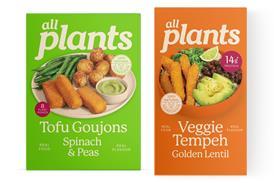



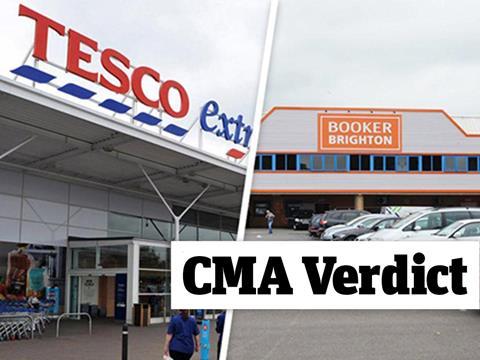
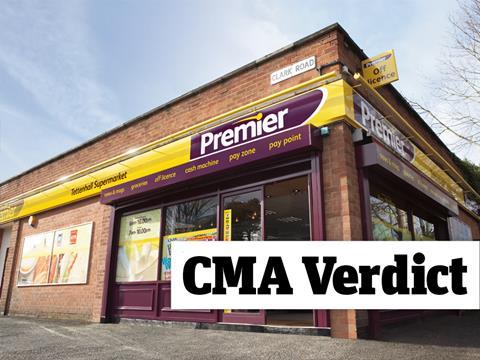
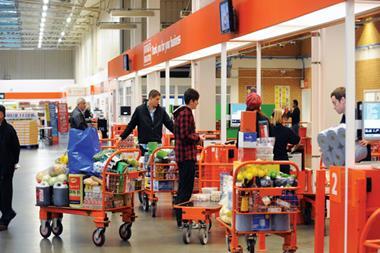
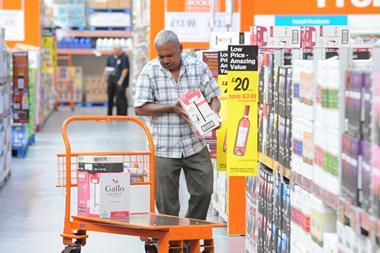

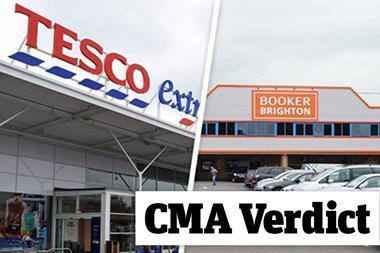

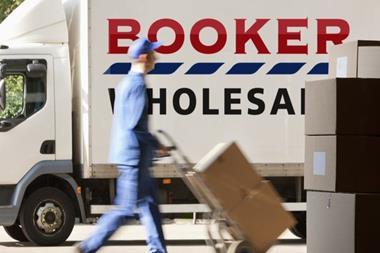


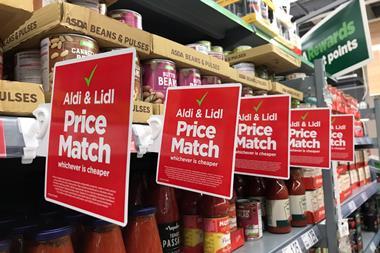

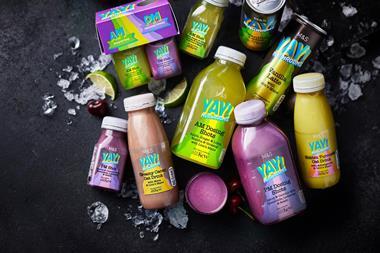

No comments yet